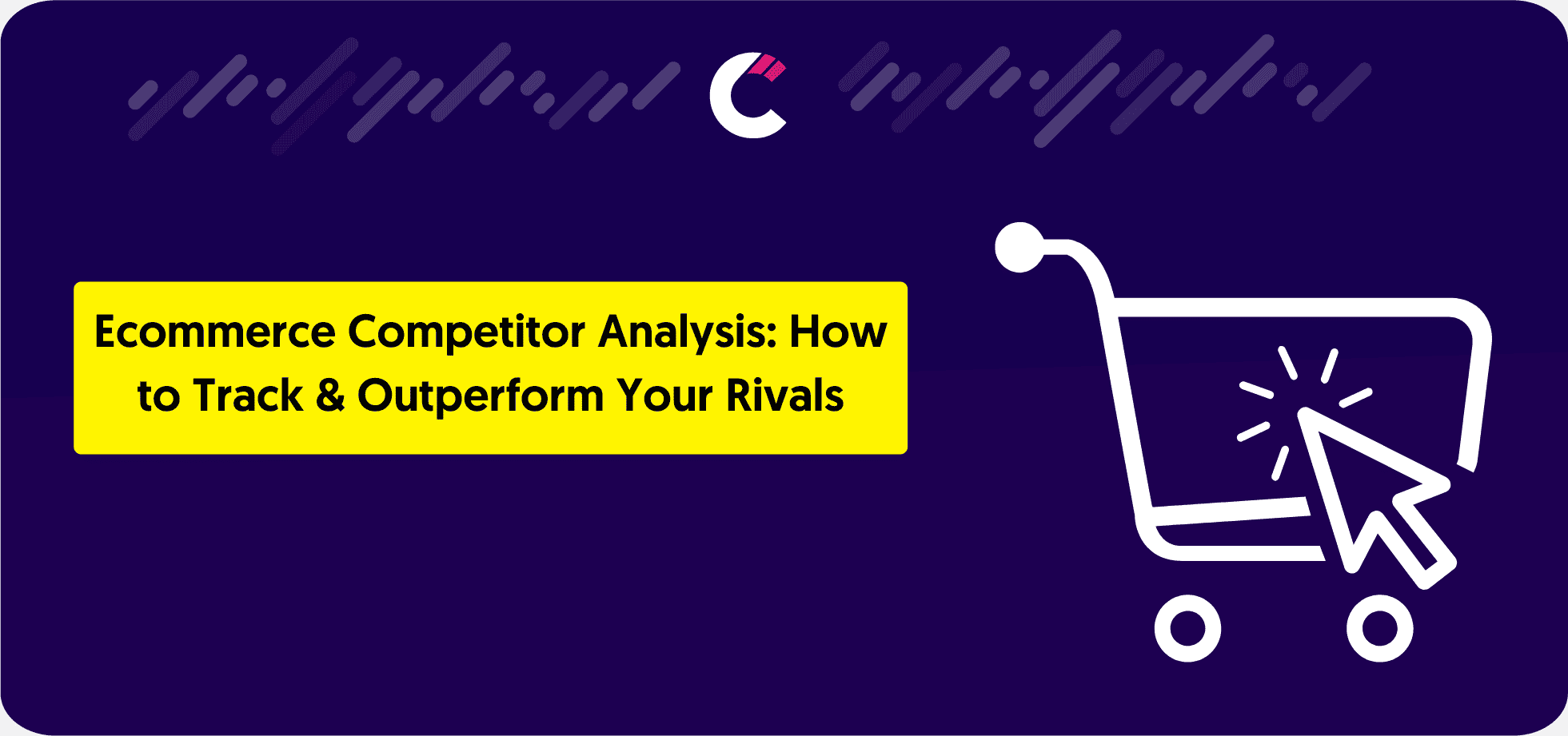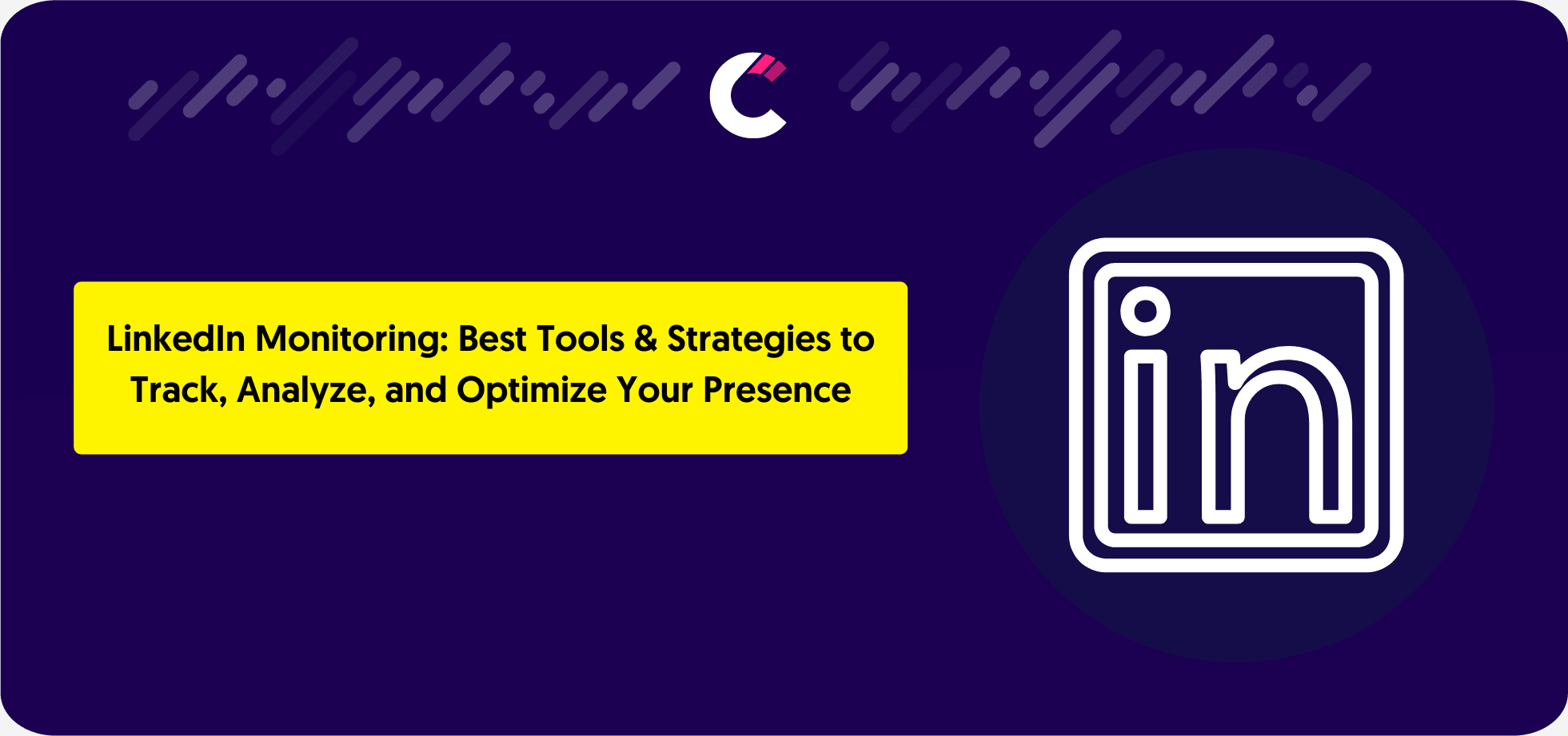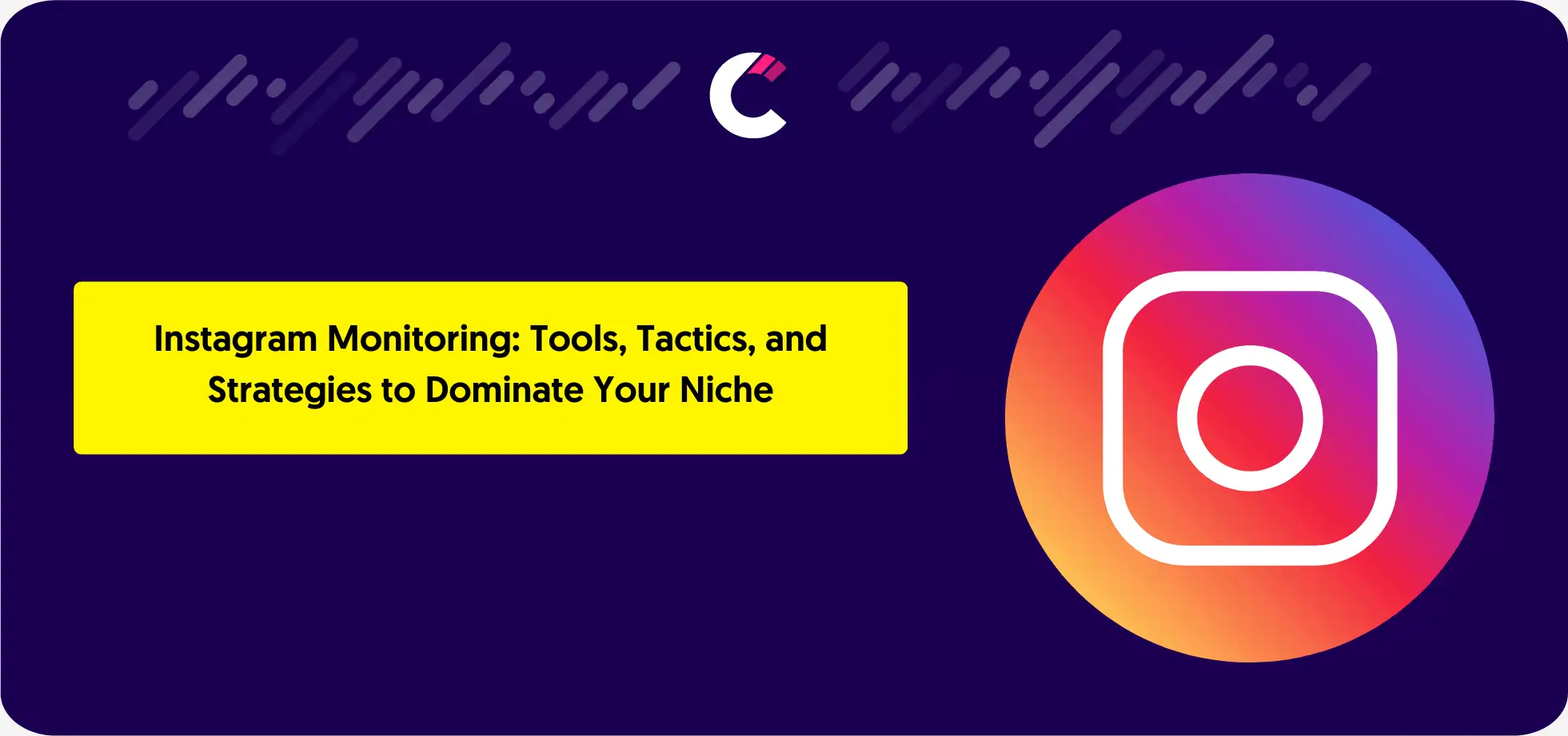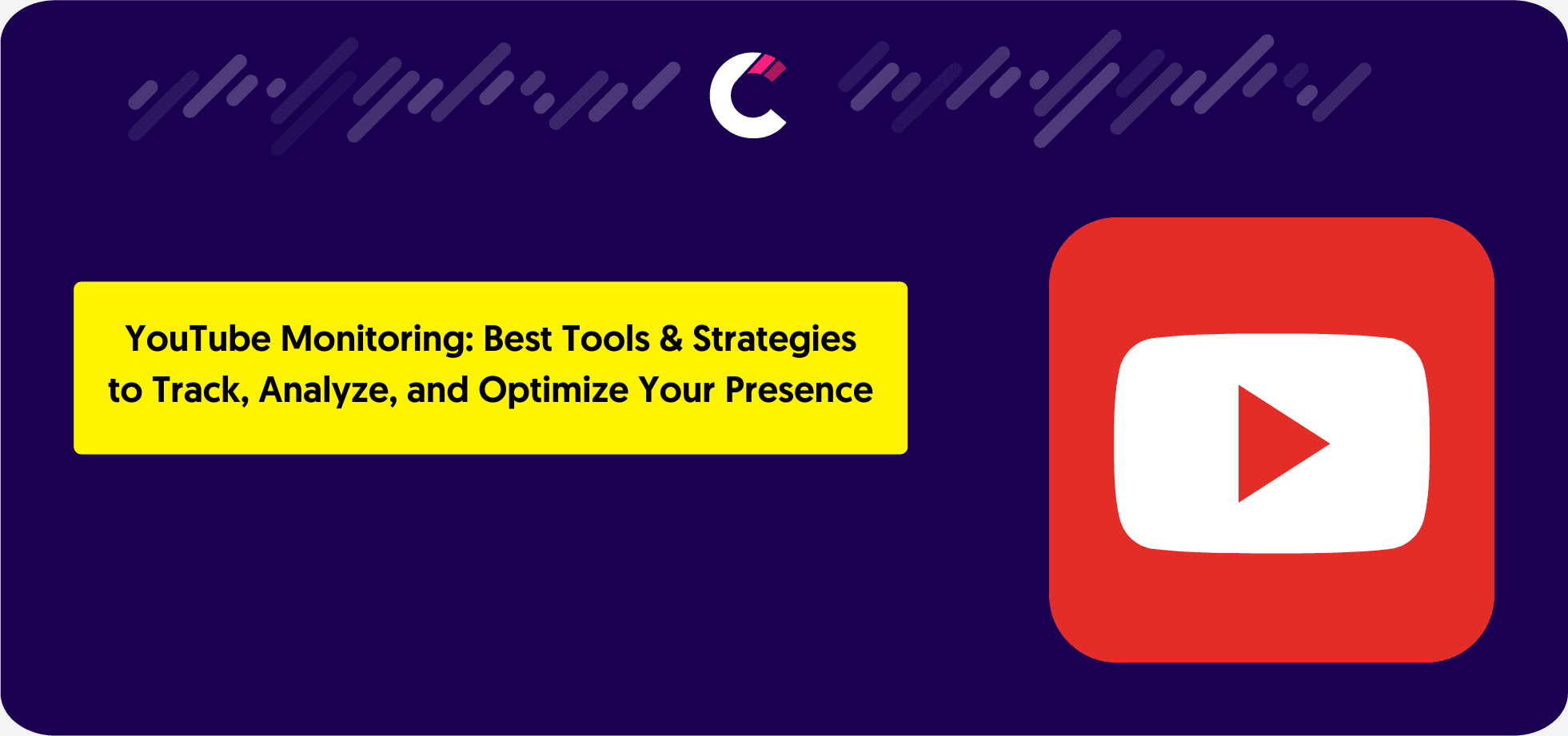What Is Ecommerce Competitor Analysis?
Imagine launching an online store, investing in marketing, and driving traffic—only to realize your competitors are constantly one step ahead. They rank higher on Google, run better ad campaigns, and offer promotions that attract more customers.
Why?
Because they’re analyzing the market, tracking competitors, and making data-driven decisions. That’s exactly what ecommerce competitor analysis helps you do: uncover what’s working for others, spot market gaps, and build a strategy that gives you the upper hand.
Competitor analysis for ecommerce isn’t about copying—it’s about understanding the playing field so you can position yourself strategically. It helps you identify opportunities, adjust your strategy, and stay competitive. Knowing how your competitors price their products, market their brand, and engage customers gives you the information needed to respond faster and make smarter decisions.
Success in ecommerce isn’t just about selling—it’s about staying ahead by knowing exactly what your competitors are doing and using that knowledge to grow.
Why Is Competitor Analysis Important for Ecommerce?
Helps with Market Positioning – Analyzing competitor branding, pricing, and messaging allows you to refine your unique selling proposition (USP) and stand out in the market.
Gaining a Competitive Advantage – Tracking competitor strategies helps you adopt what works and avoid costly mistakes, ensuring you stay ahead in pricing, marketing, and product innovation.
Identifying Strengths and Weaknesses in Your Business – Comparing your business to competitors highlights areas where you need improvement and gaps you can exploit to outperform them.
Uncovering New Opportunities for Growth – Competitor analysis reveals untapped market segments, trending product categories, and weak points in customer retention that you can turn into business opportunities.
How to Conduct Analysis Using an Ecommerce Competitor Analysis Tool – Competitors App
Manually tracking ecommerce competitors is time-consuming and inefficient. Competitors App automates this process, providing real-time insights into your competitors’ digital strategies, product updates, and marketing campaigns. Instead of guessing what works, you get data-driven intelligence to refine your approach and outperform your rivals.
Here’s how to use it effectively:
Step 1: Sign Up and Set Up Your Dashboard
Begin your journey by setting up an account with Competitors App. Take advantage of the 15-day free trial to explore the full range of features. This trial period allows you to monitor up to 10 competitors, giving you a comprehensive view of their online marketing strategies. You’ll gain insights into their main keywords, the ads and creatives they’re using, and much more. This initial step is crucial for establishing a baseline understanding of your competitive landscape.

Step 2: Identify Your Ecommerce Competitors
Use the Free Competitor Finder Tool to discover competitors in your market. This tool helps identify direct competitors selling the same products, indirect competitors targeting the same audience, and replacement competitors offering alternatives. Staying updated on emerging competitors ensures you’re always prepared to adjust your strategy.

Step 3: Add Competitors for Automated Tracking
Once you’ve identified key competitors, add them to your dashboard for continuous tracking. This allows you to monitor their marketing strategies, ad placements, SEO updates, and website changes—all from one place.
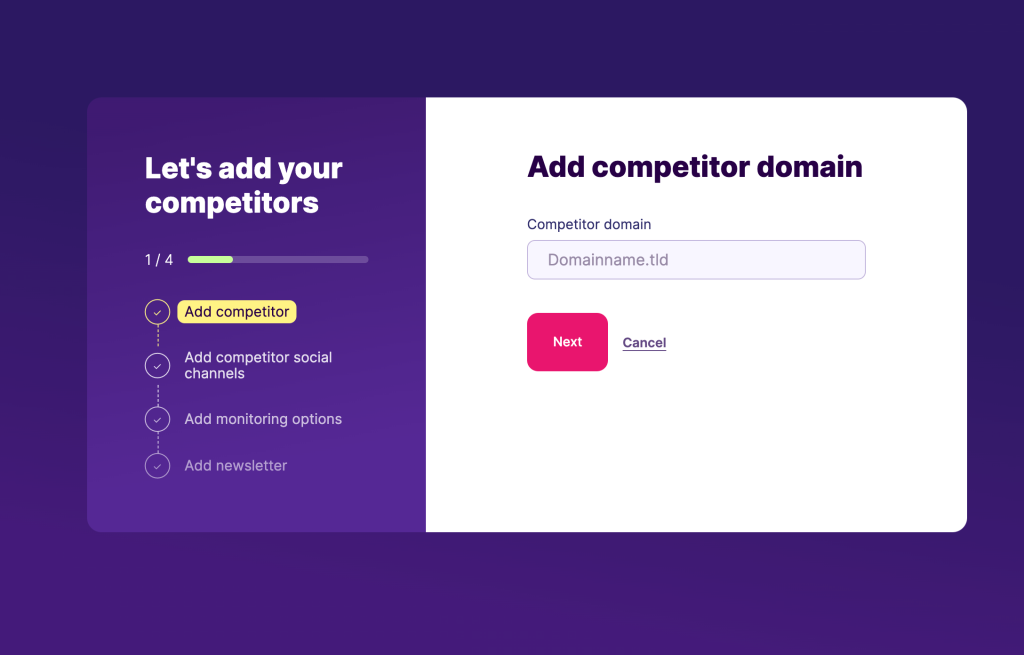
Step 4: Automate Competitor Tracking
Your Competitors App dashboard provides valuable insights, including:
- Social media activity
- Paid advertising campaigns
- SEO rankings and backlink profiles
- Website content updates
- Email marketing strategies
These insights help you spot trends, gaps, and new opportunities in your industry.
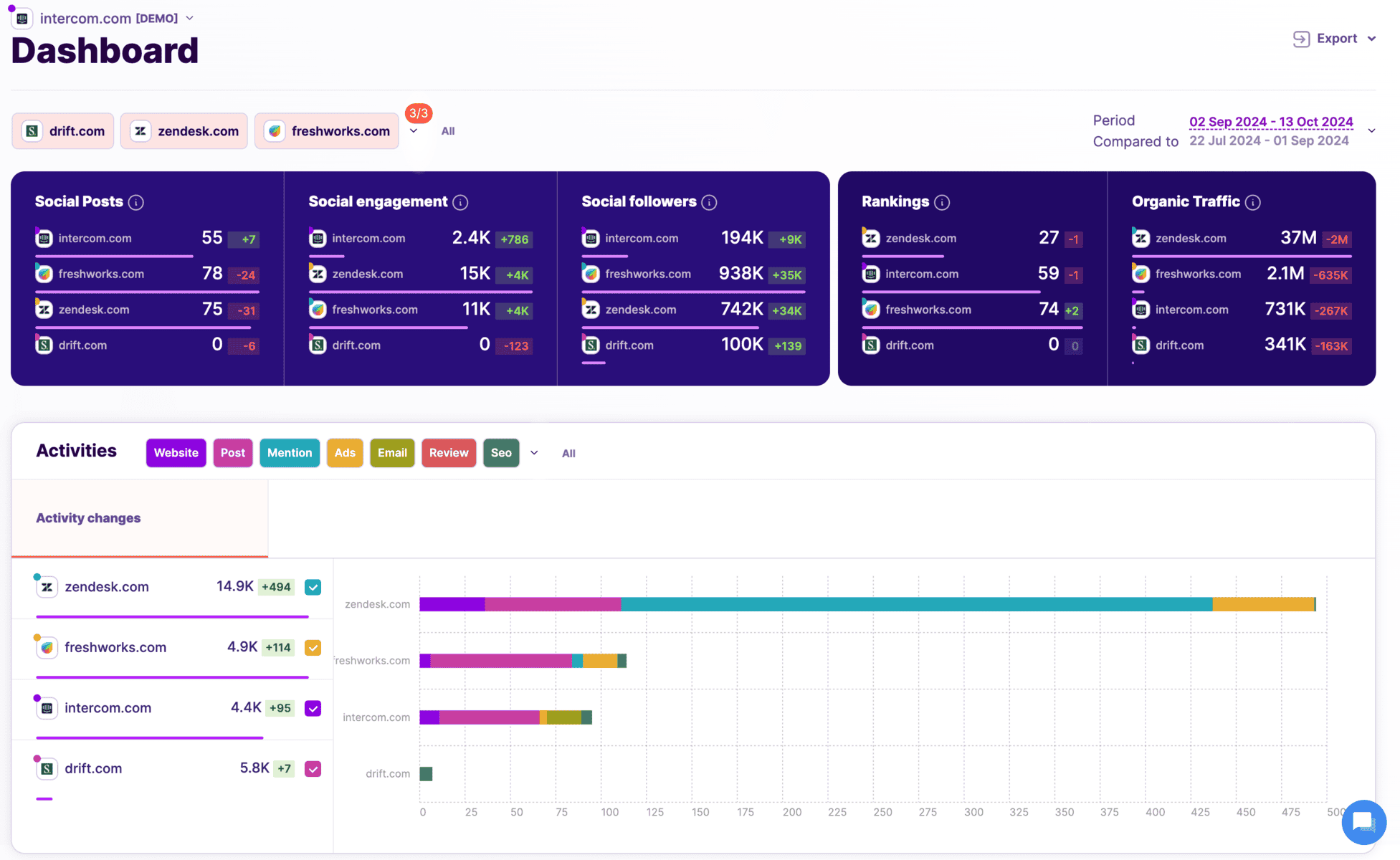
Step 5: Analyze Their Social Media Presence
See what platforms your competitors focus on, what type of content gets the most engagement, and where you can differentiate. Understanding their approach helps you refine your own content strategy.
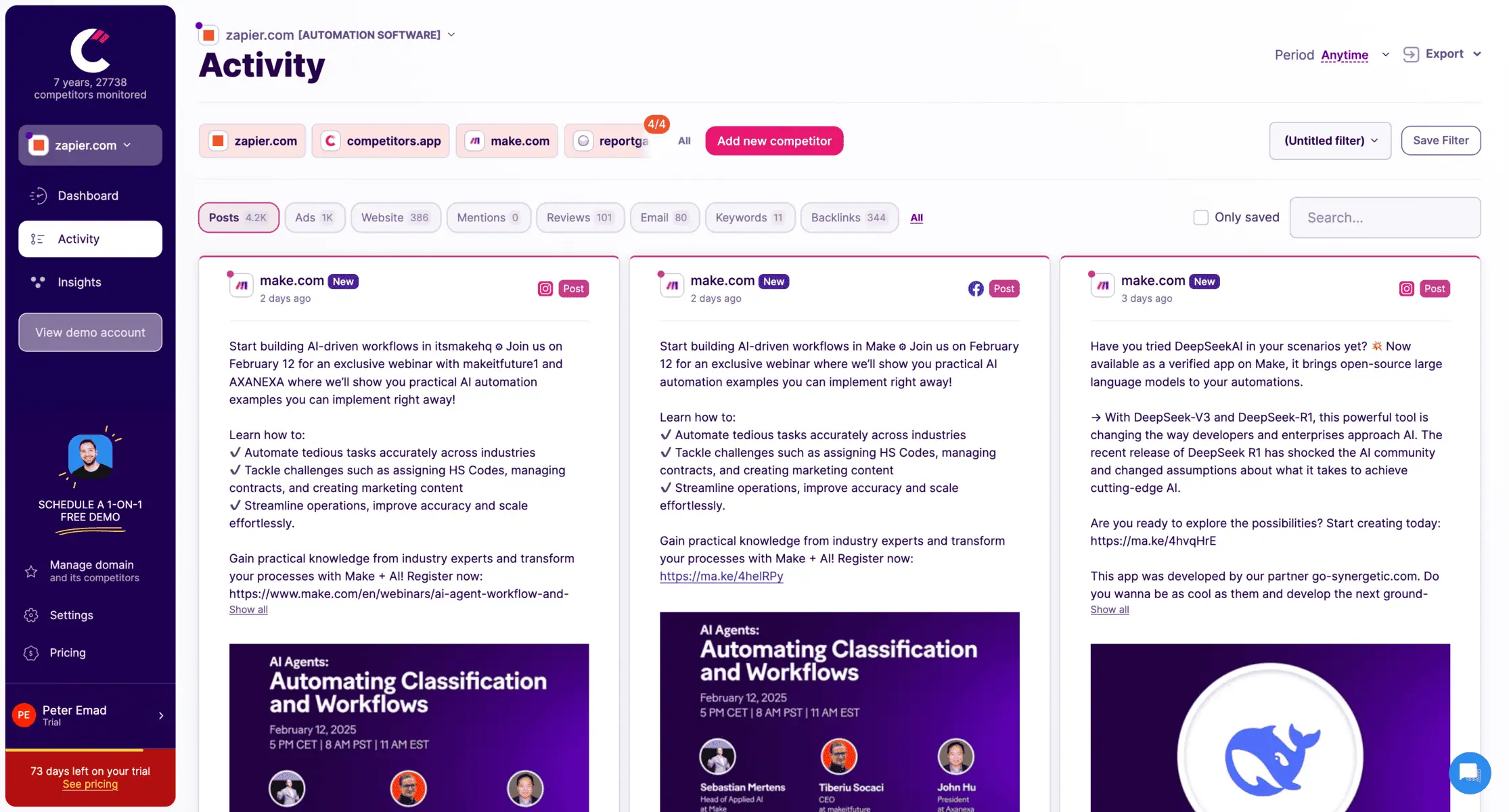
Step 6: Analyze Their Ads
Track where they’re spending their ad budget—Google Ads, Facebook Ads, or other platforms. Study their creatives, messaging, and offers to improve your own advertising strategy.
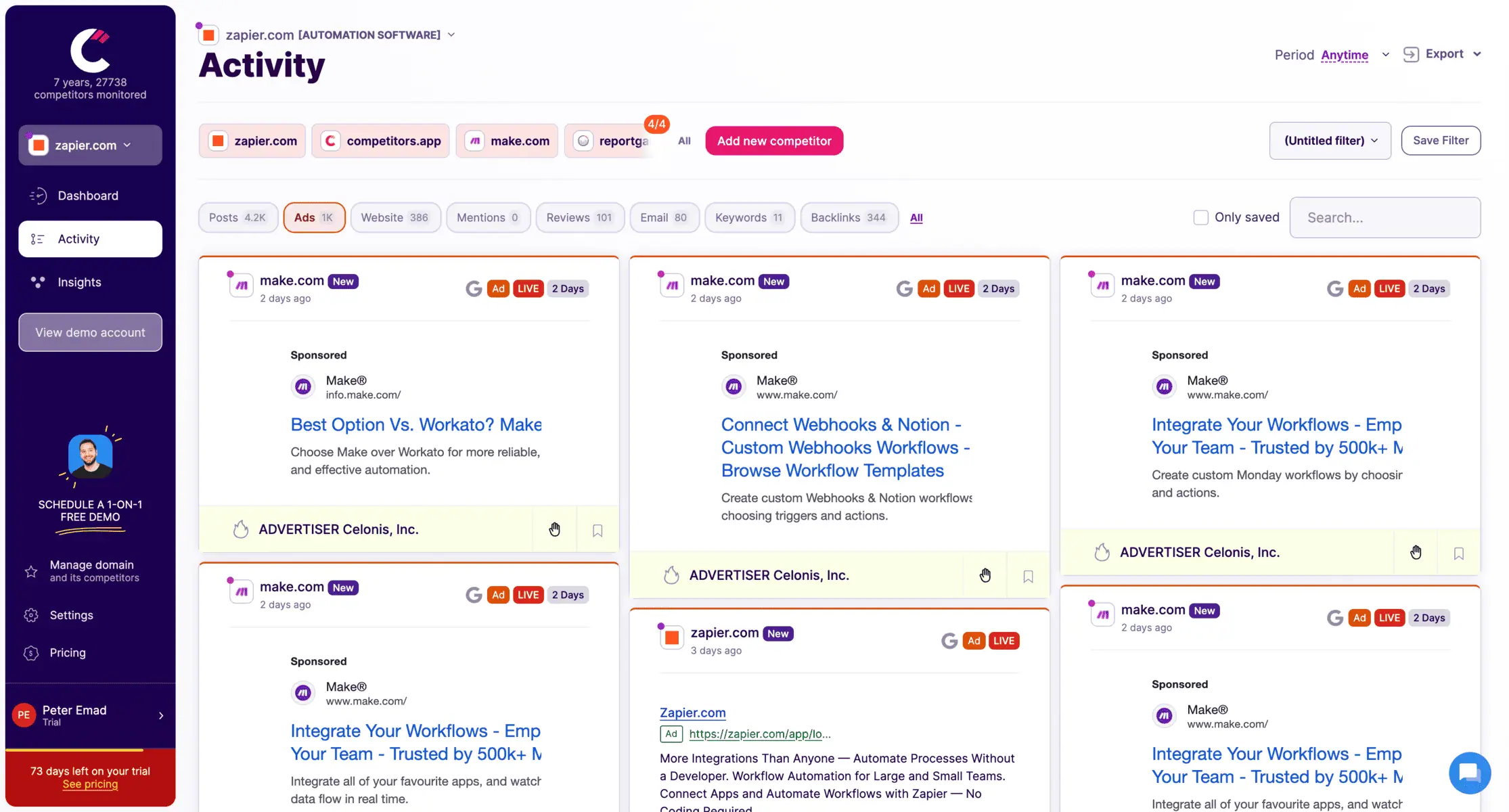
Step 7: Analyze Their SEO and Backlinks
Track how your competitors are ranking in search results, including their top-performing keywords, backlinks, and overall search visibility.
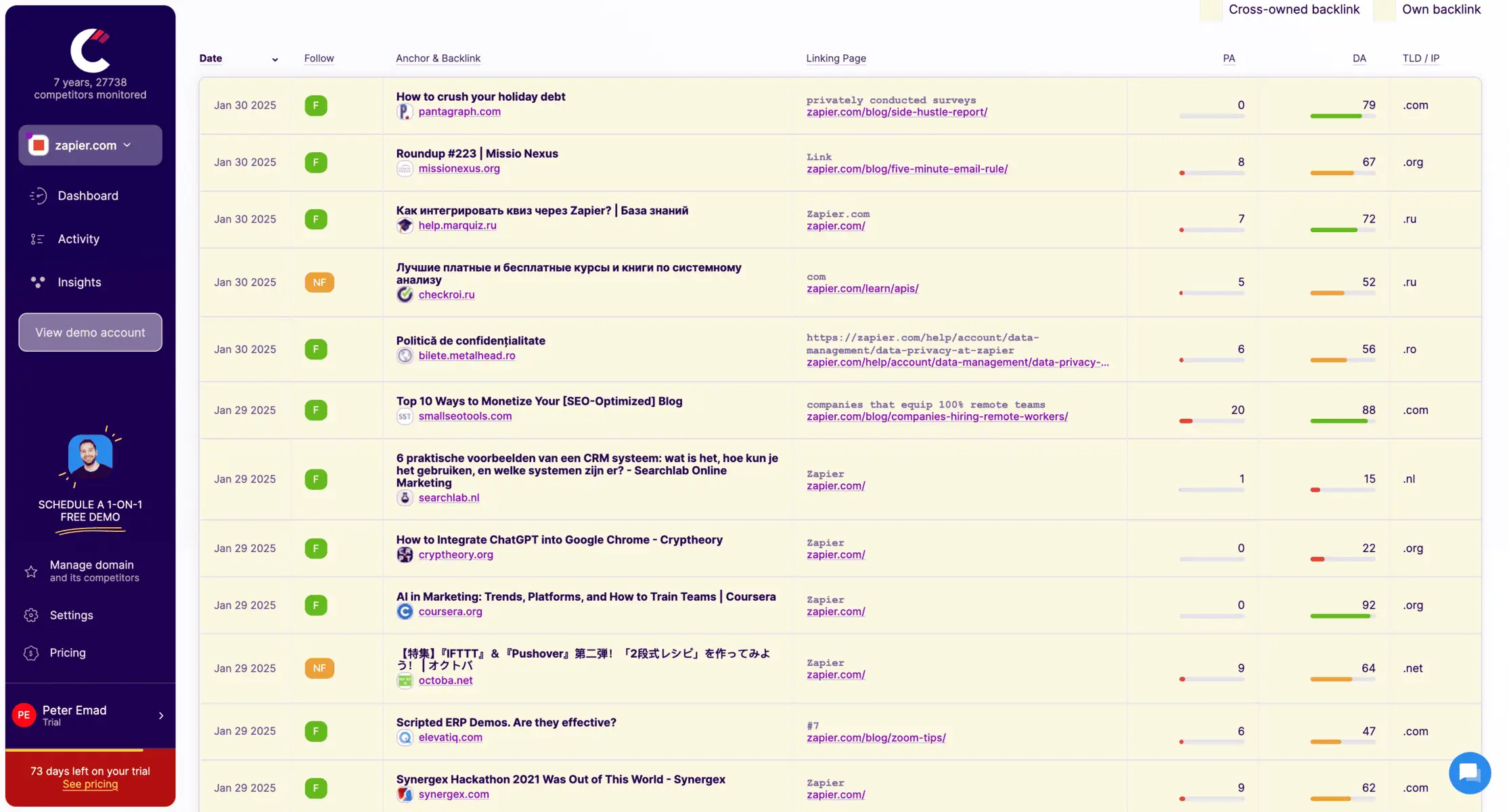

Step 8: Track Their Email Marketing Strategy
Monitor the frequency, tone, and promotional strategies of your competitors’ email campaigns. This allows you to adjust your email marketing for better engagement and conversions.
Step 9: Monitor Reviews and Customer Feedback
Keep an eye on competitor reviews from platforms like Google, Trustpilot, and G2. Understanding what customers love—or complain about—helps you position your business more effectively.
Step 10: Track Website Changes
Receive instant alerts whenever a competitor updates their website, including:
- New product or service launches
- Pricing changes
- Landing page updates
- New pages
- SEO changes
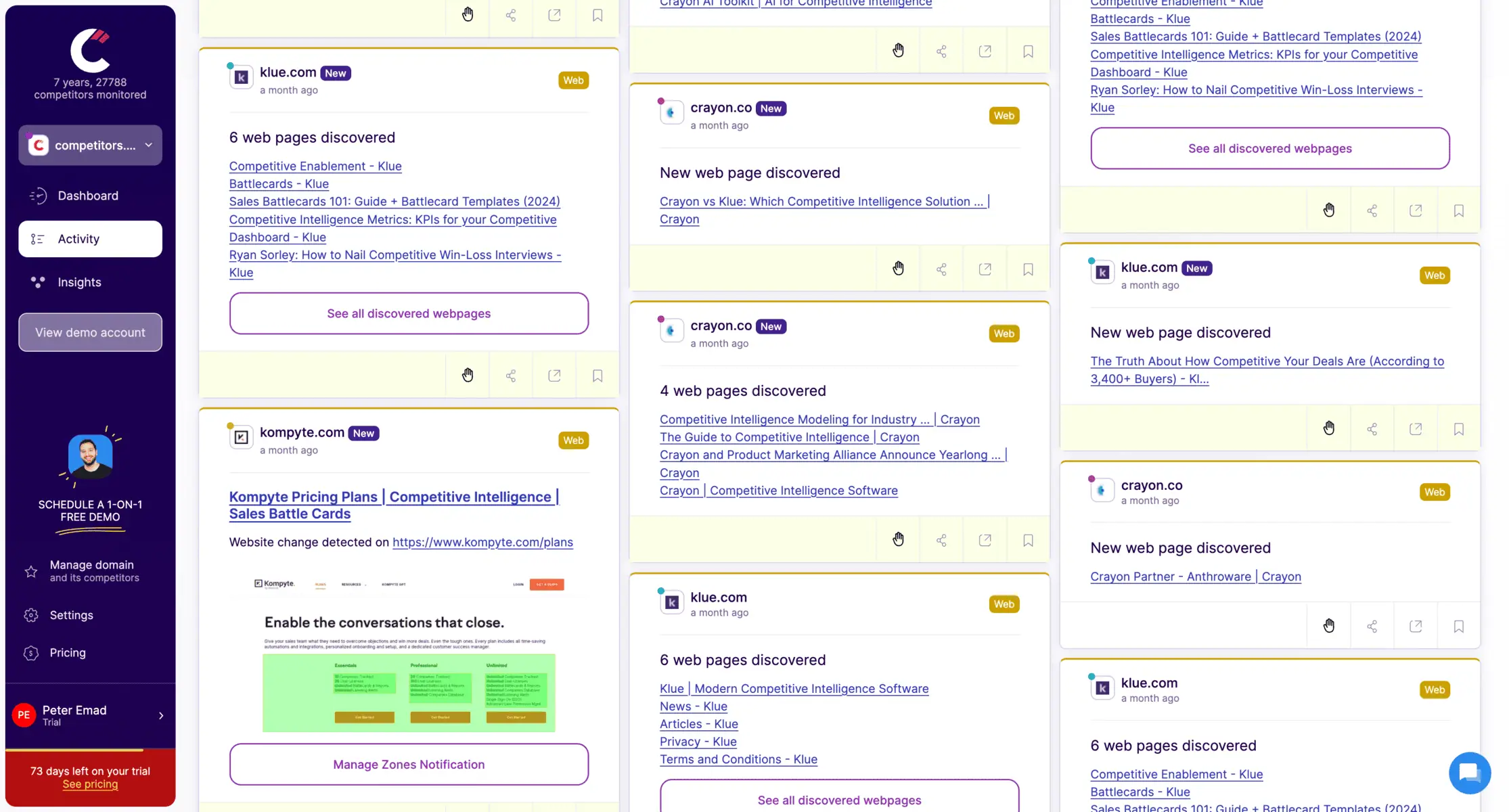
Staying informed about these changes allows you to react quickly and refine your own offerings.
By using Competitors App, you gain an automated, data-driven approach to competitor analysis, saving time while staying ahead of the competition.
Advanced Techniques for Ecommerce Competitor Analysis
Basic competitor tracking isn’t enough if you want to dominate your market. To truly stay ahead, you need deeper insights into industry trends, performance benchmarks, and strategic decision-making. Here’s how you can take ecommerce competitor analysis to the next level.
Track Market Trends & Consumer Behavior
Understanding market trends helps you predict demand shifts, pricing fluctuations, and emerging product categories. Tools like Google Trends, industry reports, and competitor insights provide data on what consumers are searching for and how buying behavior is evolving. By analyzing these trends, you can adjust your inventory, pricing, and promotions before your competitors react.
Benchmark Your Performance Against Competitors
Tracking your competitors is useful, but comparing their performance to yours is even more valuable. Key performance indicators (KPIs) like website traffic, engagement rates, and conversion rates reveal how well your business stacks up. Using tools like SimilarWeb and Ahrefs, you can compare traffic sources, customer interactions, and SEO rankings to spot gaps and opportunities for improvement.
Create a Competitive Analysis Report
Data without action is useless. Organizing your findings into a competitive analysis report allows you to make strategic decisions based on competitor insights. This report should highlight pricing trends, marketing strategies, SEO performance, customer sentiment, and emerging threats. Regularly updating this report ensures your business stays agile and responsive to changes in the ecommerce landscape.
Leveraging these advanced techniques gives you a clear strategic advantage, helping you refine your approach and outperform competitors with smarter, data-driven decisions.
Tools for Conducting Ecommerce Competitor Analysis
Using the right tools is essential for gathering competitor data efficiently. Whether you’re tracking SEO rankings, ad campaigns, website changes, or customer sentiment, these tools provide the insights needed to refine your ecommerce strategy.
Competitors App (Best Ecommerce Competitor Analysis Tool)
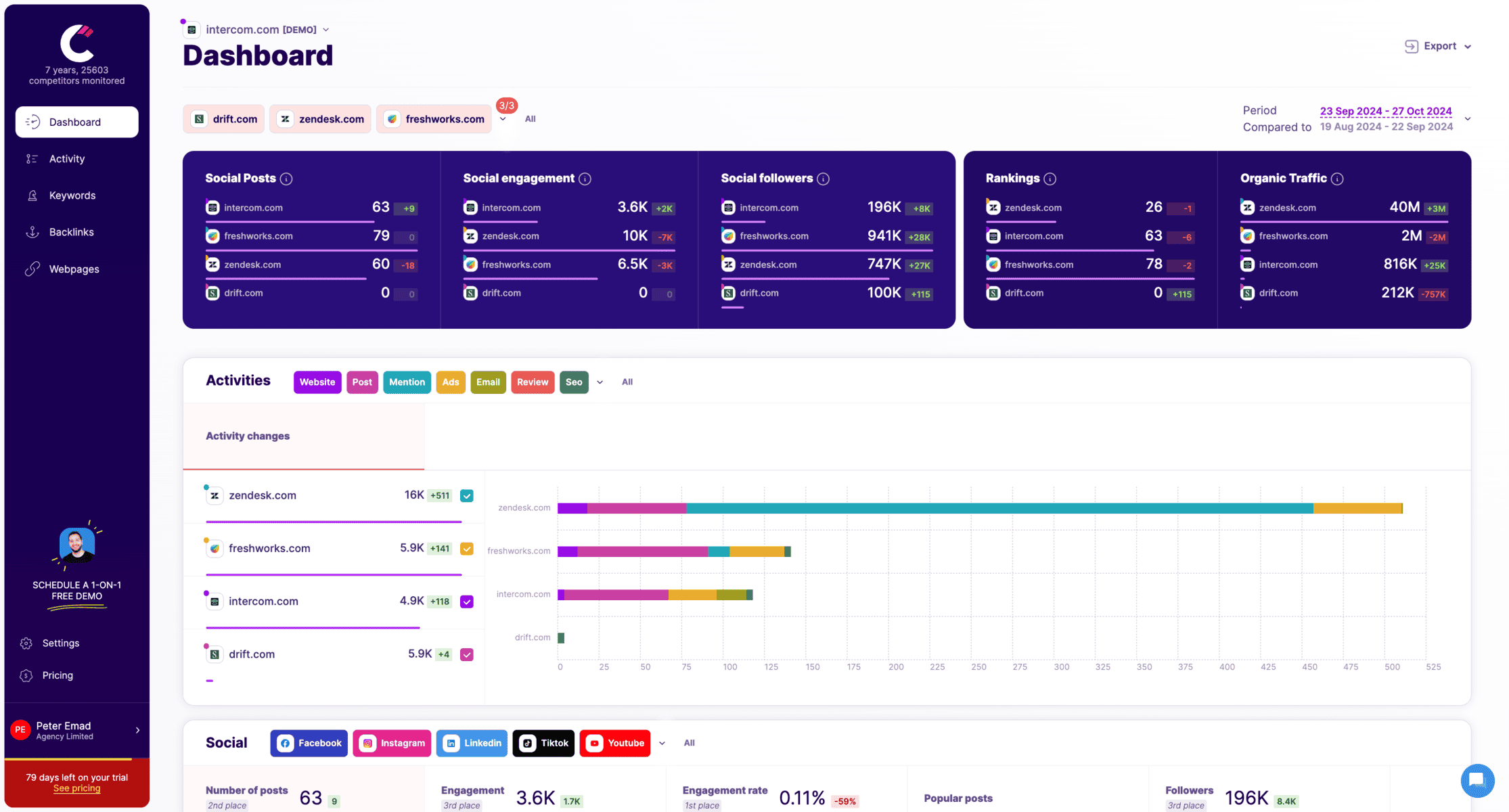
Competitors App is an all-in-one competitor tracking tool that automates the process of monitoring ecommerce rivals.
Instead of manually checking competitor websites, ads, and SEO rankings, it provides real-time alerts on:
- New product launches and website updates
- SEO rankings and keyword shifts
- Paid ad campaigns and marketing strategies
- Social media activity and content engagement
- Email marketing frequency and promotions
With everything in a single dashboard, Competitors App helps ecommerce brands stay ahead of market trends without hours of manual research.
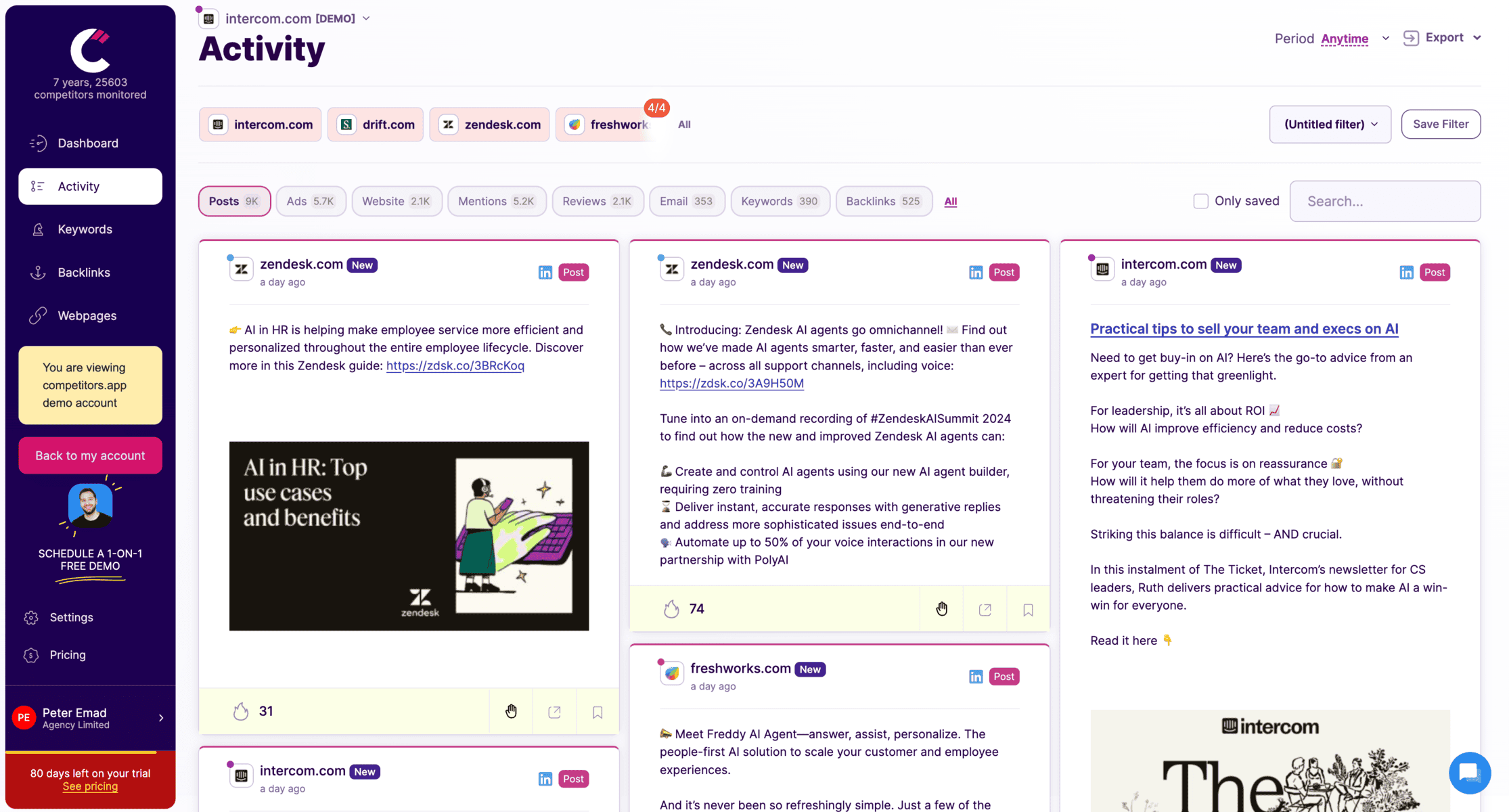
Tracks competitor social media updates across LinkedIn, Facebook, Twitter, and more.
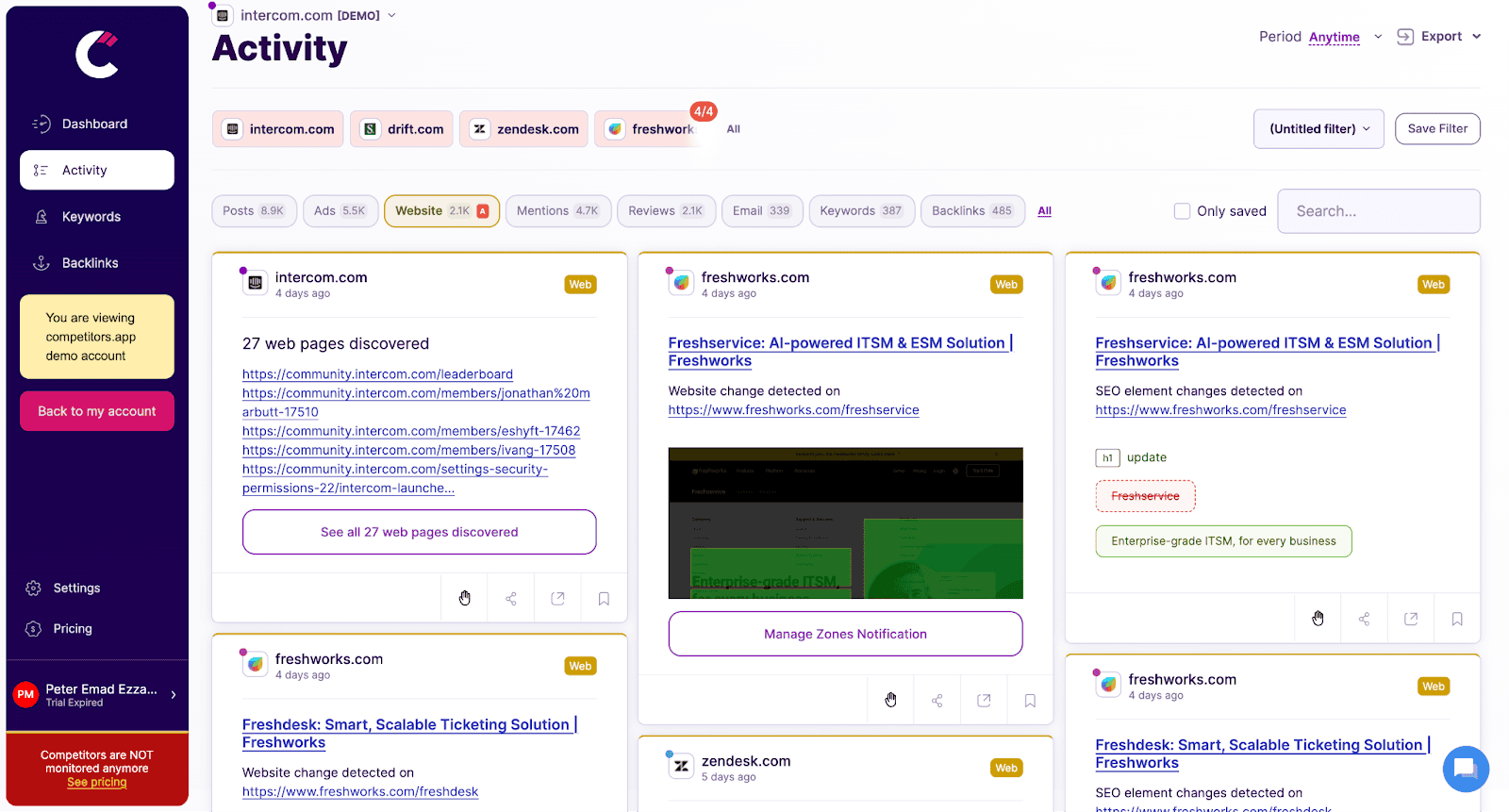
Monitors changes on competitors’ websites, such as product updates, pricing adjustments, and new messaging, providing instant alerts to help sales teams respond promptly.
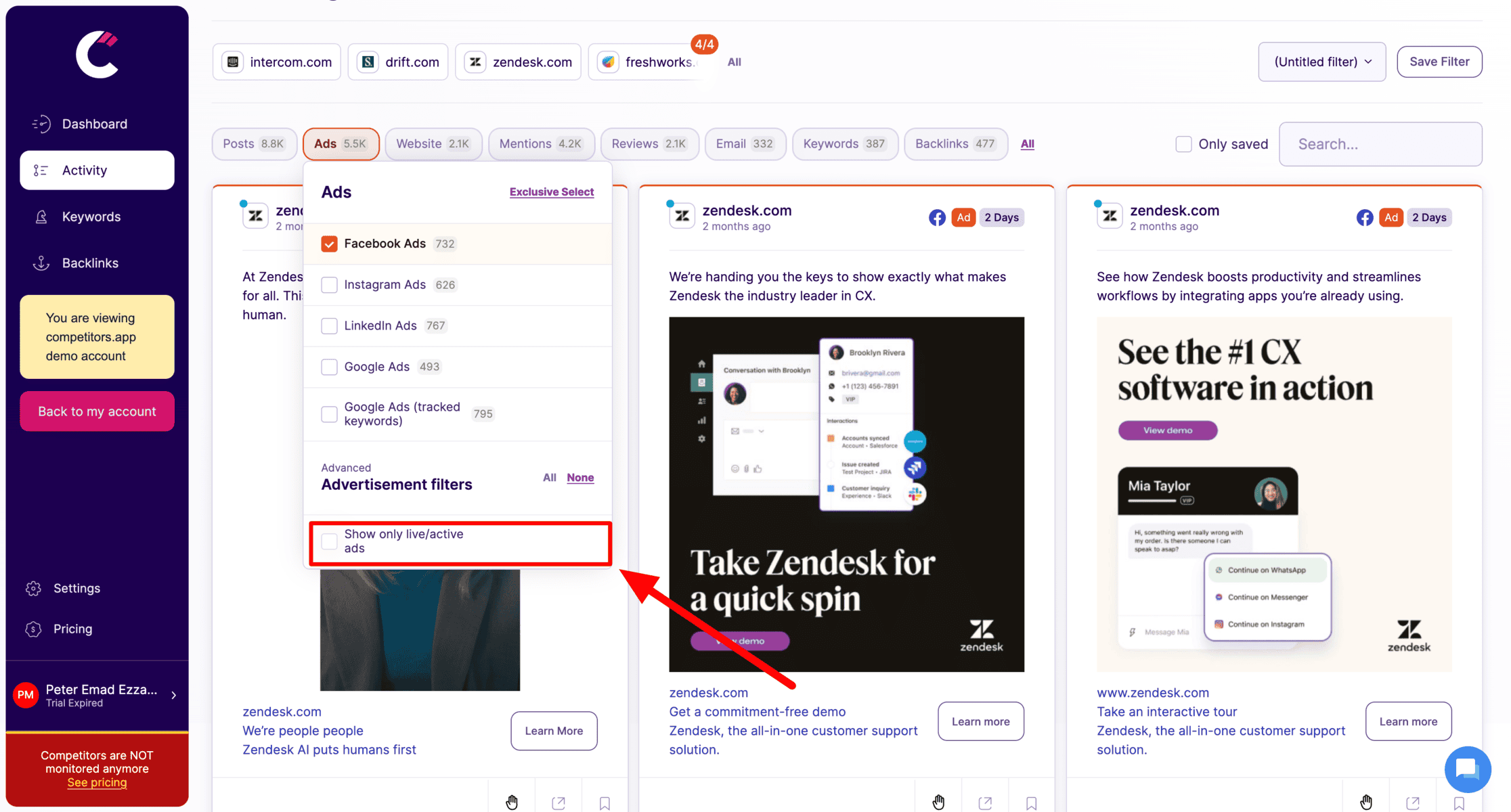
Tracks digital ad campaigns across platforms like Google Ads, Facebook, LinkedIn, and Instagram. It provides details on ad creatives, spending, and performance metrics, helping teams analyze successful ad strategies.

Analyzes competitors’ keyword strategies, organic rankings, and backlinks, allowing teams to refine their own SEO tactics and boost search visibility.

Tracks competitors’ email campaigns, including content, frequency, and engagement metrics, helping sales teams understand email tactics that drive engagement and conversions.
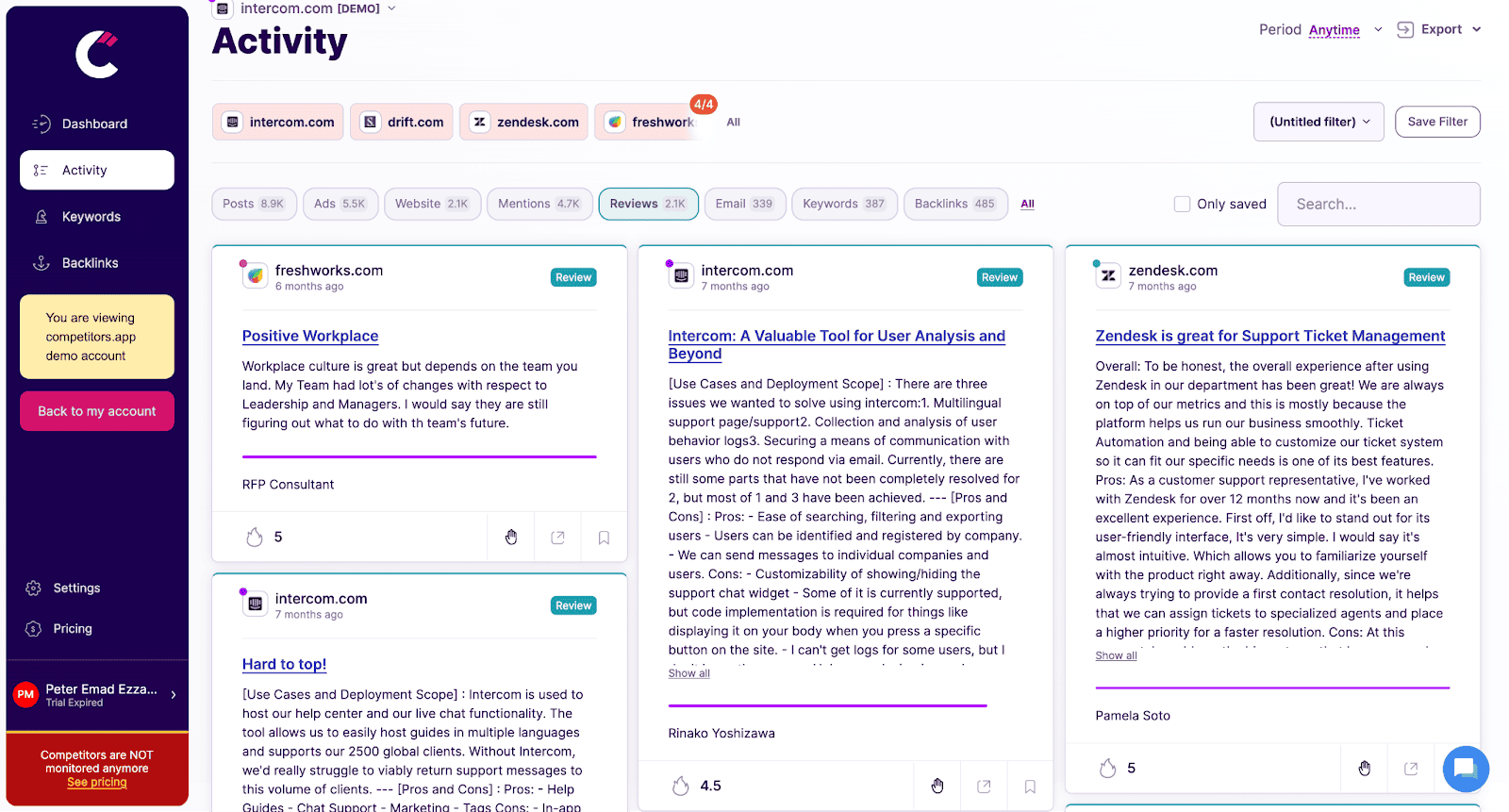
Analyzes customer reviews and ratings for competitors, providing insights into customer feedback, pain points, and product strengths, helping teams craft better sales pitches.
SEO & Keyword Analysis Tools
Tracking competitor SEO performance helps you identify top-ranking keywords, backlink sources, and content strategies that drive their traffic.
- Ahrefs – Provides in-depth backlink analysis, keyword tracking, and competitor site audits.
- Moz – Offers domain authority tracking, keyword research, and link-building insights.
- SEMrush – Comprehensive competitor research tool for keyword analysis, PPC insights, and SEO performance tracking.
PPC & Ad Intelligence Tools
Understanding where and how competitors are spending their ad budgets helps you optimize your own Google Ads, Facebook Ads, and PPC campaigns.
- SpyFu – Tracks competitor PPC campaigns, keyword bidding history, and ad copies.
- Google Ads Transparency Center – Reveals competitor Google Ads, their targeting strategies, and spending trends.
- AdBeat – Monitors competitor display ads, placements, and ad creatives for better ad strategy formulation.
Social Media Monitoring Tools
Competitor social media activity provides insights into content trends, audience engagement, and influencer partnerships.
- BuzzSumo – Tracks viral content, top-performing competitor posts, and influencer collaborations.
- Sprout Social – Monitors competitor social media engagement, post frequency, and audience interactions.
- Brandwatch – Provides sentiment analysis on social media discussions about competitor brands.
Website & UX Analysis Tools
Analyzing competitor websites helps you understand their user experience, technology stack, and conversion tactics.
- SimilarWeb – Analyzes competitor website traffic sources, visitor behavior, and engagement metrics.
- BuiltWith – Identifies the technology and tools competitors use on their websites.
- Hotjar – Provides insights into how customers interact with competitor websites through heatmaps and session recordings.
Customer Review & Sentiment Analysis
Understanding what customers say about competitors helps you identify weaknesses in their products and improve your own offerings.
- Trustpilot – Tracks competitor reviews and ratings to uncover customer pain points.
- G2 – Provides insights into competitor software and product reviews across different industries.
- ReviewTrackers – Monitors reviews across multiple platforms and provides sentiment analysis.
Using a combination of these tools ensures that your ecommerce competitor analysis is thorough and actionable, allowing you to refine your strategy, improve your marketing efforts, and stay ahead of the competition.
Common Pitfalls in Ecommerce Competitor Analysis & How to Avoid Them
Many ecommerce businesses conduct competitor analysis, but not all do it effectively. Some focus on the wrong data, while others fail to act on insights. Here are the most common mistakes and how to avoid them.
1. Treating Competitor Analysis as a One-Time Task
Competitor strategies are constantly evolving. If you only analyze them once, you risk falling behind. Trends shift, pricing changes, and new competitors enter the market. To stay ahead, ecommerce competitor analysis should be a continuous process, not a one-time effort. Using Competitors App, you can set up automated tracking and receive real-time alerts on your competitors’ moves.
2. Falling into Confirmation Bias
Many businesses only look for data that supports their existing strategy, ignoring insights that challenge their assumptions. Effective competitor analysis requires an open mind. Instead of just tracking brands you believe are your main rivals, analyze a mix of direct, indirect, and replacement competitors to get a broader market perspective.
3. Collecting Data Without Taking Action
Gathering data is useless if you don’t apply it. Some businesses track competitors but never adjust their pricing, marketing, or product strategy accordingly. Actionable insights matter more than raw data. If you see a competitor improving their SEO rankings, study their content strategy and optimize your own. If they’re launching discounts regularly, test promotional offers to see how your audience responds.
4. Copying Competitors Instead of Innovating
Competitor analysis isn’t about blindly copying others—it’s about learning what works and doing it better. If you simply mimic your competitors’ pricing, ads, and product descriptions, you’ll always be a step behind. Instead, identify gaps in their strategy and focus on areas where you can differentiate your brand. Look at their customer reviews to understand what buyers dislike and improve your offerings accordingly.
5. Failing to Adapt to Market Timing & Seasonal Trends
A pricing strategy that works during the holiday season may not be effective in off-peak months. Many businesses fail because they don’t adjust their strategy based on market timing. Track how your competitors change pricing, promotions, and ad spending during Black Friday, holiday seasons, and slow periods—then adjust your approach to stay competitive year-round.
Avoiding these mistakes ensures that your ecommerce competitor analysis remains actionable, effective, and continuously improving your business strategy.
Ecommerce Competitor Analysis FAQ
What is a competitive analysis for ecommerce?
A competitive analysis for ecommerce is the process of researching and evaluating your competitors to understand their pricing strategies, marketing efforts, product offerings, and customer engagement. This helps you identify opportunities to improve your own business and gain an edge in the market.
How do you write a competitor analysis in ecommerce?
To write an effective competitor analysis, follow these steps:
- Identify your competitors – Find direct, indirect, and replacement competitors.
- Collect data – Analyze their pricing, product range, marketing strategies, and customer feedback.
- Compare performance – Look at their strengths and weaknesses versus your own.
- Spot opportunities – Identify gaps in their strategy that you can take advantage of.
- Take action – Adjust your pricing, marketing, and product positioning based on your insights.
What’s the first step in ecommerce competitor analysis?
The first step is identifying your competitors. You need to know who you’re competing against before analyzing their strategies. Tools like Competitors App, SimilarWeb, and Ahrefs can help you discover businesses competing for the same customers.
Is SWOT a competitive analysis method?
Yes, SWOT (Strengths, Weaknesses, Opportunities, Threats) analysis is a common method used in competitor analysis. It helps you compare your business against competitors by highlighting areas where you excel, areas that need improvement, potential market opportunities, and external threats from competitor actions.
How often should you conduct a competitor analysis in ecommerce?
Competitor analysis should be an ongoing process. Markets shift, trends change, and new competitors emerge. Using tools like Competitors App allows you to automate tracking and receive real-time updates, so you’re always aware of competitor movements. A full in-depth competitor analysis should be conducted at least quarterly, with continuous monitoring in between.
What happens if I don’t analyze my competitors?
Without competitor analysis, you’re making business decisions blindly. You won’t know if your prices are competitive, if your marketing strategy is effective, or if your customers are leaving for better alternatives. Tracking competitors ensures you stay relevant and avoid losing market share to brands that continuously optimize their strategy.
